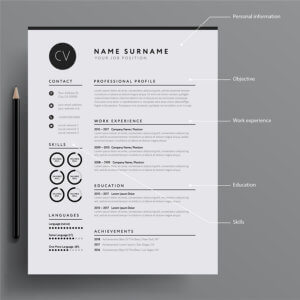Resumes don’t need a preamble since they are so widely used in the professional world that anyone, no matter the position, will likely have had to draft one at some point. Generally under two pages in length, they provide a summary of the applicant’s skills, work history, and education, especially the information that is specifically tailored for the job. Depending on the format and content, your resume can make the hiring process much easier for the HR, and in order to hit the nail on the head, below are some of the points you definitely need to consider while drafting your resume.
First Things First, or Not?
As a rule of thumb, your professional experience gets more sophisticated as you go up the career ladder.
For this reason, put your most recent job on top of the list and go in reverse chronological order with the rest.
This format allows the reader to see the logical progression in the tasks that you have managed and helps the reader to determine your overall job readiness.

Alternatively, you can opt for a functional resume.
This format is beneficial for those who are changing a career path and want to highlight those experiences that best fit the requirements for the desired position.
In a functional resume, you don’t list your jobs in chronological order but select those positions that best show your skills and abilities.
Free Quick and Easy Resume Builder – Try it Out Today!
If you’re looking to create a professional-looking resume quickly, our professional resume builder Resumist.com is the answer.
Our platform is simple yet effective and will help you create the perfect resume in just a few steps.
We have plenty of professionally designed resume templates and examples for you to consider. We’ll even inspire you with a few CV-enhancing edits and suggestions throughout the process. Our resume builder knows what recruiters and employers are looking for.
Choose from our already made resumes and expect HR managers and recruiters to contact you in no time. Best of all, our online resume wizard is totally free to use.
Need help with your resume? Give our services a try!
Five Main Parts of a Resume

Regardless of the format, a typical resume will consist of five main sections: personal information, the objective, work experience, education, and skills. Here are a few tips for each of these.
Personal information. Email, LinkedIn, contact phone number and a website are usually placed in the heading along with your full name and sometimes a photo. Additionally, some jobs require you to include your age and date of birth. However, personal details such as sex, race, sexual orientation, political affiliation, religion, and family information are omitted to avoid any potential prejudice or discrimination.
Objective. This is a short paragraph of up to 50-200 words where you include a strong trait of yours, a few relevant professional skills, the reason for applying for the job as well as the potential value you will bring to the company.
These sentences should be written in third person – substitute “I” for the desired or current position.
Work experience. In addition to providing details of where and how long you have worked, list your tasks and achievements in bullet points.
Omit pronouns and use past tenses for your previous jobs.
For your current job, use present tense for the typical tasks and past tense for your achievements or tasks you no longer manage.
Include action verbs, results, percentages, and numbers to give context to your responsibilities and to avoid vague statements.
Education. Again going in reverse order, include your main education, e.g. university degree, and add relevant training courses.
You may want to omit obvious qualifications, i.e. high school, unless there are certain achievements you’d like to include.
When it comes to describing each stage in your education, demonstrate your leadership skills by including information about your academic results, initiatives and projects as well as awards.
Skills. To avoid mix and match between soft and hard skills, separate them into different groups. And when it comes to language proficiency, include the ones you will be using as part of your job to avoid clutter.
Now that the content part of the resume is covered, let’s talk about the tools that can help you to design your resume without resorting to tables in Microsoft Word.
Useful Platforms
Europass CV
This website allows you design a resume in Europass format, a widely accepted format in Europe and Russia.
Once you’ve registered, you need to fill out a personal profile which you then can use both to search for jobs and to create a CV.
Once you’ve provided all the information, you can opt for one of the three Europass designs.
Keep in mind that you will need to add the objective in each new CV separately as the website doesn’t save it in your profile. Your final document will be in PDF.
In addition to a plethora of designs, Canva has multiple sections with ready-to-fill resumes.
Here you will find templates for professional, modern, high school, simple, corporate, and creative resumes.
Once you select a design, all you need to do is to substitute information in the template with your details.
To save your work, press an arrow in the top right corner and select either PDF, PNG, JPEG, MP4, or GIF.
With the free version of the website, you first select a template and register an account.
Then you choose your current level of experience by selecting one of the options: student, graduate, intermediate, senior, or freelancer.
The page layout where you fill in the information looks similar to Canva’s, however, once you select a section, a pre-filled form pops up and guides you through what to write down first.
To create more than one CV, you will need to upgrade your account to a professional one, the cost of which ranges from EUR 10-15.
In addition to templates for the resume, the website offers guides on how to write cover letters and what to include in your CV.
With multiple real examples of CVs and letters of intent presented in the blog section, you can always refer to those resources for inspiration.
Once you register, you will need to choose a CV template – so be aware that free templates are located on the very bottom of the page and are marked with the “Free” caption.
If you fancy a Pro template, the system will ask you to pay for the $12/month membership before you can download the resume.
Additional Resources for CV Writing

The American-based international listing website Indeed offers great resume writing tips that emphasize the importance of key words in a job posting and offers dozens of ideas for proofreading. Another recruiting website, Glassdoor, gives advice on how to catch recruiters’ attention by including the names of your previous clients and utilizing your hobbies to your advantage.

If you want to take your resume writing skills to a new level, here is an online course on how to do just that! Offered by the State University of New York, the course encourages you to apply the tips directly to your experience so that you have a ready-to-go resume upon completing the course.
Resume writing is a must-have skill for anyone who considers career development within the corporate setting. Given the ever-increasing workload for recruiters, attention-grabbing is becoming crucial for prospective candidates to secure a spot at the interview.
Photos: Shutterstock / Edited by: Martina Advaney
More articles to kickstart your career!
Support us!
All your donations will be used to pay the magazine’s journalists and to support the ongoing costs of maintaining the site.
Share this post
Interested in co-operating with us?
We are open to co-operation from writers and businesses alike. You can reach us on our email at [email protected]/[email protected] and we will get back to you as quick as we can.










